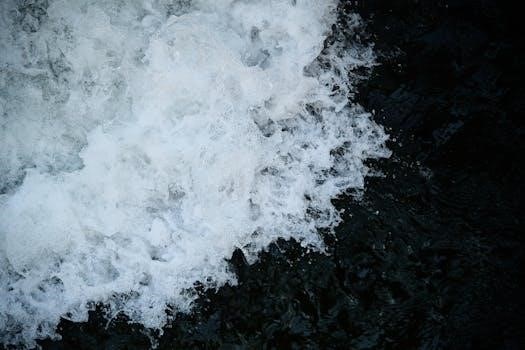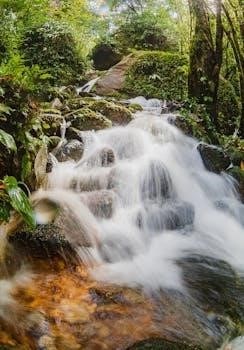
Energy Flow in Ecosystems⁚ An Overview
Energy flow in an ecosystem is the transfer of energy from one organism to another․ It starts with sunlight captured by producers and moves through consumers and decomposers․ This transfer is vital for ecosystem function and organism survival․ The flow is unidirectional․
Energy flow is a fundamental concept in ecology, describing how energy moves through an ecosystem’s various components․ It begins with the primary source, typically solar radiation, which is captured by producers like plants through photosynthesis․ This process converts light energy into chemical energy stored in organic molecules․ From producers, energy flows to consumers, organisms that obtain energy by feeding on other organisms․ These consumers include herbivores, carnivores, and omnivores, each occupying different trophic levels within the food chain or web․ Energy transfer between trophic levels is not perfectly efficient․ Some energy is lost as heat during metabolic processes․ As a result, the amount of energy available decreases at each successive trophic level․ This energy flow dictates the structure and function of the ecosystem․
The Source of Energy⁚ Solar Radiation
Solar radiation serves as the primary energy source for most ecosystems․ Producers, like plants and algae, harness this energy through photosynthesis․ This process converts solar energy into chemical energy, fueling life․
Photosynthesis and Energy Conversion
Photosynthesis is the cornerstone of energy flow in ecosystems․ It’s the process by which producers, primarily plants and algae, convert light energy from the sun into chemical energy․ This conversion is crucial, as it transforms unusable solar energy into a form that organisms can utilize․ Plants use chlorophyll to capture sunlight and convert carbon dioxide and water into glucose, a sugar molecule․ This glucose stores the captured solar energy in its chemical bonds․ Oxygen is released as a byproduct of photosynthesis․ This process forms the base of most food chains, providing energy for all other trophic levels within the ecosystem․ The efficiency determines energy availability․
Trophic Levels and Energy Transfer
Trophic levels represent an organism’s position in a food chain․ Energy transfer occurs between these levels as organisms consume each other․ Each level depends on the one below for energy, illustrating the interconnectedness of an ecosystem․
Producers (Autotrophs)
Producers, also known as autotrophs, form the base of the food chain by capturing energy from sunlight through photosynthesis․ They convert solar energy into chemical energy, stored as glucose․ These organisms, primarily plants and algae, provide the initial energy source for all other organisms in the ecosystem․ Producers use some of this energy for their own metabolic processes and growth, while the remaining energy is available to be consumed by the next trophic level, the consumers․ The amount of energy initially captured by producers dictates the overall energy available within an ecosystem, influencing the size and complexity of the food web․ Their role in energy fixation is vital for sustaining life․
Consumers (Heterotrophs)
Consumers, or heterotrophs, obtain energy by consuming other organisms․ They are classified into different trophic levels based on their feeding habits⁚ primary consumers (herbivores) eat producers, secondary consumers (carnivores) eat primary consumers, and tertiary consumers (top carnivores) eat secondary consumers․ Each level derives energy from the level below, but energy transfer is inefficient, with a significant portion lost as heat during metabolic processes․ Consumers play a crucial role in transferring energy through the ecosystem, influencing the population dynamics of both their prey and their predators․ Their feeding interactions shape the structure and stability of food webs and the flow of nutrients․ The energy available decreases with each increasing trophic level․
Decomposers (Detritivores)
Decomposers, also known as detritivores, play a vital role in the energy flow within an ecosystem by breaking down dead organic matter, such as dead plants, animals, and waste products․ They obtain energy from this detritus through decomposition, releasing nutrients back into the environment․ These nutrients are then available for producers to use, completing the cycle of energy and matter within the ecosystem․ Common decomposers include bacteria, fungi, and invertebrates like earthworms․ Their activity is essential for maintaining soil health, nutrient availability, and overall ecosystem stability․ Decomposers effectively link all trophic levels by processing dead organisms from each level․ In this way, they support the continuous flow of energy and cycling of materials․

Food Chains and Food Webs
Food chains and food webs illustrate the flow of energy through ecosystems․ Food chains show a linear sequence, while food webs depict interconnected relationships․ Both models help visualize energy transfer between organisms at different trophic levels․
Energy Transfer Efficiency⁚ The 10% Rule
Energy transfer efficiency in ecosystems is often described by the 10% rule․ This rule suggests that only about 10% of the energy stored in one trophic level is transferred to the next․ The remaining 90% is lost as heat during metabolic processes, respiration, and other activities․ This loss limits the length of food chains because there isn’t enough energy to support many trophic levels․ Consequently, higher trophic levels receive significantly less energy than lower levels․ The 10% rule impacts ecosystem structure, affecting biomass and population sizes at each level․ Understanding this inefficiency is crucial for understanding energy dynamics․

Y-shaped Energy Flow Model
The Y-shaped energy flow model represents the two major pathways of energy flow in an ecosystem⁚ the grazing food chain and the detritus food chain․ This model acknowledges that energy can enter an ecosystem through either of these pathways․ The grazing food chain begins with producers that are consumed by herbivores, while the detritus food chain starts with dead organic matter consumed by decomposers․ The Y-shaped model highlights the interconnectedness of these two chains, as energy can move between them․ This model provides a more realistic view of energy flow compared to a simple linear food chain․ It accounts for the different energy pathways․
Ecological Pyramids
Ecological pyramids are graphical representations that illustrate the trophic levels in an ecosystem․ These pyramids depict the flow of energy or biomass from producers to consumers, showcasing the decreasing amount of energy available at each level․
Energy Pyramids
Energy pyramids are a type of ecological pyramid that visually represents the energy flow within an ecosystem․ Each level of the pyramid represents a trophic level, with producers forming the base and subsequent levels representing consumers․ The pyramid shape illustrates that energy decreases as it moves up trophic levels․ This decrease is due to the second law of thermodynamics, where some energy is lost as heat during metabolic processes․
Only a fraction of the energy stored in one trophic level is transferred to the next․ Energy pyramids are crucial for understanding energy transfer and ecosystem efficiency․ They highlight energy availability within food chains․
Biomass Pyramids
Biomass pyramids represent the total mass of living organisms at each trophic level in an ecosystem․ Typically, biomass decreases as you move up the pyramid, reflecting energy flow․ Producers, forming the base, have the highest biomass․ Consumers have successively lower biomass at each level․ This pattern occurs because energy is lost as heat and waste, limiting the amount of biomass that can be supported at higher levels․
However, biomass pyramids can be inverted in aquatic ecosystems․ The rapid reproduction of phytoplankton (producers) can support a larger biomass of zooplankton (consumers)․ Biomass pyramids offer insights into ecosystem structure and function․

Energy Flow and Material Cycling
Energy flow and material cycling are interconnected processes vital for ecosystem function․ Energy flows unidirectionally, starting with solar energy captured by producers, then transferred through trophic levels․ At each transfer, energy is lost as heat, following the second law of thermodynamics․
Material cycling, in contrast, involves the continuous reuse of elements like carbon, nitrogen, and phosphorus․ Decomposers play a key role, breaking down organic matter and releasing nutrients back into the environment․ These nutrients are then taken up by producers, completing the cycle․ Energy flow drives material cycling, ensuring the sustained productivity and stability of ecosystems․
Factors Affecting Energy Flow
Several factors influence the efficiency and magnitude of energy flow within an ecosystem․ The availability of sunlight, the primary energy source, directly impacts the rate of photosynthesis by producers․ Temperature affects metabolic rates of organisms, influencing energy expenditure․
Nutrient availability limits primary productivity, impacting energy input into the food web․ The structure of the food web, including the number of trophic levels and complexity of feeding relationships, affects energy transfer efficiency․ Disturbances like pollution, deforestation, and climate change disrupt energy flow, leading to ecosystem imbalances․ Understanding these factors is crucial for ecosystem management․

Importance of Energy Flow in Ecosystems
Energy flow is fundamental to the structure and function of ecosystems․ It sustains all life by providing the necessary energy for growth, reproduction, and maintenance of organisms․ The flow determines the abundance and diversity of species within an ecosystem․ Efficient energy transfer supports complex food webs, enhancing ecosystem stability․
Energy flow links different trophic levels, ensuring nutrient cycling and decomposition․ Understanding energy flow is vital for assessing ecosystem health․ Disruptions in energy flow can lead to declines in populations, loss of biodiversity, and ecosystem collapse․ Conservation efforts must focus on maintaining healthy energy pathways for long-term sustainability․